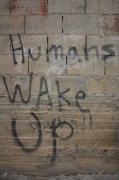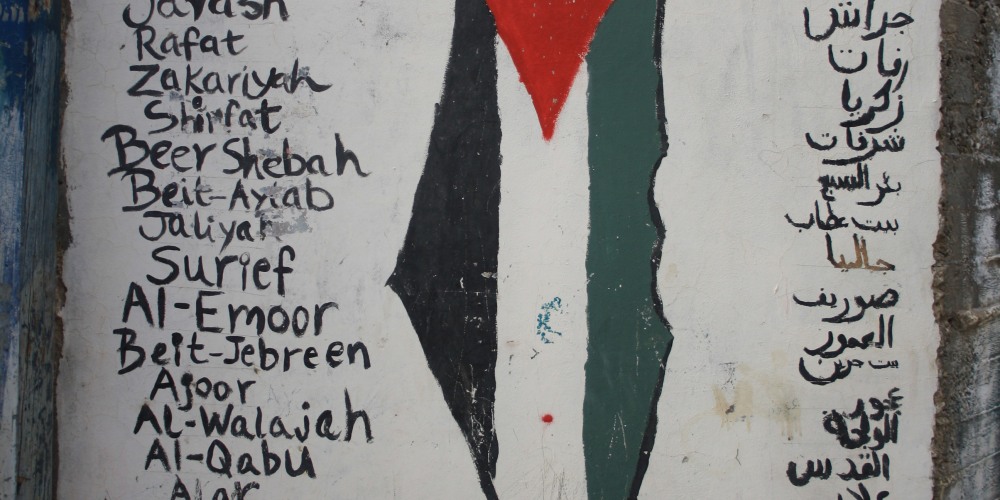In the last few days I’ve seen so many things that it’s hard for me to decide where to start from: I left home thinking that I already knew everything about Palestine and the conflict only to come here and realize that what Palestians have to face every day cannot be described with words. The more I know the more I feel powerless and yet I am conscious that I want knowledge; that I need it to keep my humanity complete, that only if I keep my eyes open I can say to be alive.
On one of the outside walls of Aida refugee camp someone wrote “Humans wake up!”  We pass by and take pictures, then we go home and we share them thinking that we can do something about it, that we can show them and talk about them and raise awareness, but do we really wake up from our comfortable torpor? Walking in the narrow muddy alleys of this refugee camp I had the impression of living a bad dream. The reality I’ve been living in clashed with the one I saw there, as if that was not a real life situation but an artificial village, a simulation of life. Truth is, that was the reality and I had just been sleeping all my life. Waking up to reality is extremely unpleasant and irritating because it takes its share of humiliation and the admission that we’ve been wrong all along. Waking up hurts, but it is necessary to deserve living.
We pass by and take pictures, then we go home and we share them thinking that we can do something about it, that we can show them and talk about them and raise awareness, but do we really wake up from our comfortable torpor? Walking in the narrow muddy alleys of this refugee camp I had the impression of living a bad dream. The reality I’ve been living in clashed with the one I saw there, as if that was not a real life situation but an artificial village, a simulation of life. Truth is, that was the reality and I had just been sleeping all my life. Waking up to reality is extremely unpleasant and irritating because it takes its share of humiliation and the admission that we’ve been wrong all along. Waking up hurts, but it is necessary to deserve living.
At a first glance, Aida refugee camp seems a quite decent place to live. A Palestinian friend tells me “Do not deceive yourself, this is a five-star camp”. Still it feels odd to enter in it by a huge door topped by an enormous key and a graffiti saying “We will return”, as if you were entering a parallel world cut out from reality.
This refugee camp was built in 1950 by the UN to host the people fleeing from 17 demolished villages of the northwestern area of Jerusalem, during the 1948 war. It was initially made up by 94 green, fabric tents tents and hosted 1,125 refugees, with the promise that they would have shortly returned to their houses. In 1956, UNRWA replaced these tents with cinder block housing units, each with one or two rooms measuring just 9×12 meters. New rooms started to appear on top of each other like sand-castles and the camp became a city in the city, with its shops and its schools. Although the camp’s population continued to grow, its area didn’t and the current population is over 4,700 refugees living in 277 housing units: the result is a huge fake doll-house effect, an overcrowded labyrinth that gives the feeling to be trapped inside it. Nobody ever returned, because their houses do not exhist anymore. 
In the Aida Youth Center we met Habashi and Karim, two activists who have grown up in Aida and who work in this center for the kids of the camp organizing various activities, sports and trainings. They took us on a tour and showed us the buildings: many have bullet holes in the walls, a mark left by the frequent gunfire and the strikes and invasions operated by the Israeli army during the first and the second Intifada. The tallest building of the camp is a school with no windows. “You want to know why there’s no windows?” Habashi asked. “In 2002, 20 kids were wounded by a bomb thrown by the soldiers, so they had to brick up all the windows”.

While I watch little boys running around and hiding behind the corners I ask myself: how is it like to be afraid to go to school? To be afraid of playing soccer in the streets because a random gasbomb can be thrown at any time? To grow up playing at throwing rocks at the soldiers? Psychologically speaking it is devastating: in Gaza, a place where kids are 40% of the total population, the vast majority of the kids have been diagnosed with Post-Traumatic Stress Disorder. Only here you can find kids who try to commit suicide, kids who have no desire to live anymore. As Habashi guides us in the maze of streets and stairs he tells us how he used to live in one room with 17 people, and they used to take turns to sleep. He was put in prison when he was 18 with his 15 years-old brother. Why? “You are terrorists” was the answer. I never thought a kid could be a terrorist, never thought a kid could be jailed for throwing stones at the soldiers who stole him his childhood.
All refugees kept the key of their houses, and all of them have an ID who identifies them as refugees, the only paper they have to proove that they have the right to return. There are 85 refugee camps for Palestinians in the West Bank, Gaza, East Jerusalem, Syria and Lebanon, and 5 million people holding their refugee ID. None of them did anything to deserve it and yet only the walls here are screaming to this injustice: poems and paintings of colorful lands filled with olive trees, forgotten landscapes of the old destroyed villages. “Here only the birds and the butterflies are free”, says the wall. The people don’t say anything anymore, but on their chest they hold on to their key.


“as if you were entering a parallel world cut out from reality ” never a better description